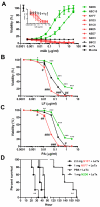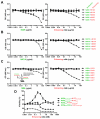Disease-enhancing antibodies improve the efficacy of bacterial toxin-neutralizing antibodies
- PMID: 23601104
- PMCID: PMC3633089
- DOI: 10.1016/j.chom.2013.03.001
Disease-enhancing antibodies improve the efficacy of bacterial toxin-neutralizing antibodies
Abstract
During infection, humoral immunity produces a polyclonal response with various immunoglobulins recognizing different epitopes within the microbe or toxin. Despite this diverse response, the biological activity of an antibody (Ab) is usually assessed by the action of a monoclonal population. We demonstrate that a combination of monoclonal antibodies (mAbs) that are individually disease enhancing or neutralizing to Bacillus anthracis protective antigen (PA), a component of anthrax toxin, results in significantly augmented protection against the toxin. This boosted protection is Fc gamma receptor (FcγR) dependent and involves the formation of stoichiometrically defined mAb-PA complexes that requires immunoglobulin bivalence and simultaneous interaction between PA and the two mAbs. The formation of these mAb-PA complexes inhibits PA oligomerization, resulting in protection. These data suggest that functional assessments of single Abs may inaccurately predict how the same Abs will operate in polyclonal preparations and imply that potentially therapeutic mAbs may be overlooked in single Ab screens.
Copyright © 2013 Elsevier Inc. All rights reserved.
Figures







Similar articles
-
A monoclonal antibody to Bacillus anthracis protective antigen defines a neutralizing epitope in domain 1.Infect Immun. 2006 Jul;74(7):4149-56. doi: 10.1128/IAI.00150-06. Infect Immun. 2006. PMID: 16790789 Free PMC article.
-
In vitro and in vivo characterization of anthrax anti-protective antigen and anti-lethal factor monoclonal antibodies after passive transfer in a mouse lethal toxin challenge model to define correlates of immunity.Infect Immun. 2007 Nov;75(11):5443-52. doi: 10.1128/IAI.00529-07. Epub 2007 Aug 20. Infect Immun. 2007. PMID: 17709410 Free PMC article.
-
[Screening of full human anthrax lethal factor neutralizing antibody in transgenic mice].Sheng Wu Gong Cheng Xue Bao. 2016 Nov 25;32(11):1590-1599. doi: 10.13345/j.cjb.160049. Sheng Wu Gong Cheng Xue Bao. 2016. PMID: 29034628 Chinese.
-
Monoclonal antibody therapies against anthrax.Toxins (Basel). 2011 Aug;3(8):1004-19. doi: 10.3390/toxins3081004. Epub 2011 Aug 15. Toxins (Basel). 2011. PMID: 22069754 Free PMC article. Review.
-
Antibodies against anthrax: mechanisms of action and clinical applications.Toxins (Basel). 2011 Nov;3(11):1433-52. doi: 10.3390/toxins3111433. Epub 2011 Nov 16. Toxins (Basel). 2011. PMID: 22174979 Free PMC article. Review.
Cited by
-
B cells and antibodies in the defense against Mycobacterium tuberculosis infection.Immunol Rev. 2015 Mar;264(1):167-81. doi: 10.1111/imr.12276. Immunol Rev. 2015. PMID: 25703559 Free PMC article. Review.
-
A novel single-domain antibody multimer that potently neutralizes tetanus neurotoxin.Vaccine X. 2021 May 29;8:100099. doi: 10.1016/j.jvacx.2021.100099. eCollection 2021 Aug. Vaccine X. 2021. PMID: 34169269 Free PMC article.
-
Generation and Characterization of Human Monoclonal Antibodies Targeting Anthrax Protective Antigen following Vaccination with a Recombinant Protective Antigen Vaccine.Clin Vaccine Immunol. 2015 May;22(5):553-60. doi: 10.1128/CVI.00792-14. Epub 2015 Mar 18. Clin Vaccine Immunol. 2015. PMID: 25787135 Free PMC article.
-
Human IgG Fc domain engineering enhances antitoxin neutralizing antibody activity.J Clin Invest. 2014 Feb;124(2):725-9. doi: 10.1172/JCI72676. Epub 2014 Jan 9. J Clin Invest. 2014. PMID: 24401277 Free PMC article.
-
When two are better than one: Modeling the mechanisms of antibody mixtures.PLoS Comput Biol. 2020 May 4;16(5):e1007830. doi: 10.1371/journal.pcbi.1007830. eCollection 2020 May. PLoS Comput Biol. 2020. PMID: 32365091 Free PMC article.
References
-
- Ablowitz The theory of emergence. Phil Sci. 1939;6:1–16.
-
- Aderem A, Underhill DM. Mechanisms of phagocytosis in macrophages. Annu Rev Immunol. 1999;17:593–623. - PubMed
Publication types
MeSH terms
Substances
Grants and funding
LinkOut - more resources
Full Text Sources
Other Literature Sources

